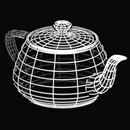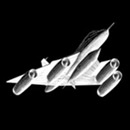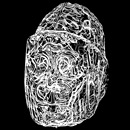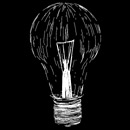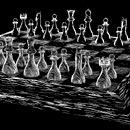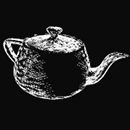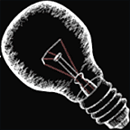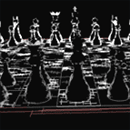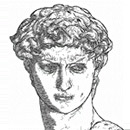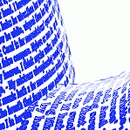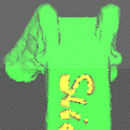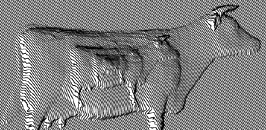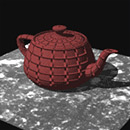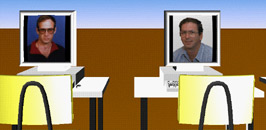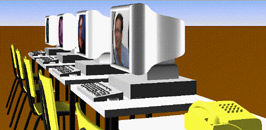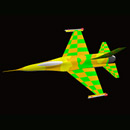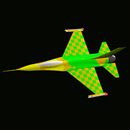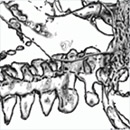Rendering with depth cueing for both rendered using rayshade images (left) and postscript figures (right). The postscript version also supports haloed lines. Both examples were created using tools that are part of the IRIT modeling environment.
Adaptive extraction of isoparametric curves is employed herein to create illustrative imagery exploiting different shaders. The image on the left enhances silhouette regions while the image on the right uses cosine shader.
Line art illustrations are created in this project, using strokes that are developed out of point distributions on the freeforms. This scheme can be employed for both parametric and implicit forms. Here, the chess set and the light bulbs are two examples of parametric forms, whereas the tubes' joint is a result of an implicit iso surface defined over a trivariate polynomial function and the facial figure is an output of an iso surface extraction out of the MRBrain model from UNC. both last examples employs the principal curvatures as the direction of the strokes. Created using the IRIT modeling environment.
This work presents a line art rendering method for freeform polynomial and rational surfaces that is capable of achieving real time and interactive display. A careful preprocessing stage that combines an a-priori construction of line art strokes with proper classification of the strokes, allows one to significantly alleviate the computational cost of sketching based rendering, and enable interactive real time line art display. The images of the Utah teapot and the transparent light bulb were extracted off an interactive session on an O2 SGI whereas the chess set was extracted off an interactive session on an Onyx Reality Engine SGI. All examples were created using tools that are part of the IRIT modeling environment.
A new method for the layout of text strings over some given free-form parametric base curves is considered. Each letter of the string is represented by a collection of cubic and linear Bezier curves. The layout of the string over the free-form parametric curve is derived as a symbolic composition of the string geometry (i.e. a sequence of Bezier curves) and a free-form parametric surface S(u,v) with the parameters u, v between zero and one, and S(u,0) is given by the base curve. This method has proven to provide great flexibility and give high quality results in layout of text. Similar text is also seen in the image on the left laid down along a spiral.
A new method for the layout of text strings over some given free-form parametric base curves is considered. Each letter of the string is represented by a collection of cubic and linear Bezier curves. The layout of the string over the free-form parametric curve is derived as a symbolic composition of the string geometry (i.e. a sequence of Bezier curves) and a free-form parametric surface S(u,v) with the parameters u, v between zero and one, and S(u,0) is given by the base curve. This method has proven to provide great flexibility and give high quality results in layout of text. Similar text is also seen in the image on the left laid down along a spiral.
An artistic rendering method of free-form surfaces with the aid of half-toned text that is laid-out on the given surface is presented. The layout of the text is computed using symbolic composition of the free-form parametric surface S(u,v) with cubic or linear Bezier curve segments C(t) = { cu(t), cv(t) }, comprising the outline of the text symbols. Once the layout is constructed on the surface, a shading process is applied to the text, affecting the width of the symbols as well as their color, according to some shader function. The shader function depends on the surface orientation and the view direction as well as the color and the direction or position of the light source.
This work presents an interactive direct rendering paradigm of trivariate B-spline functions, that can be employed in trivariate modeling sessions, such as interactive volumetric sculpting. The rendering is conducted from a fixed viewpoint and in two phases. The first, preprocessing, stage accumulates the affect that the coefficients of the trivariate function have on the pixels in the image. This preprocessing stage is conducted off line and once only per trivariate and viewing direction. The second stage allows the rendering of trivariate functions, at rates of several frames per second. During a sculpting operation, the artist can sculpt the volume and get displayed feedback, in interactive rates.
This work presents an artistic rendering scheme that is based on parallel stripes and inspired by Victor Vasarely's art work. The rendering process is conducted using parallel planar curves that are warped and translated in the projection plane an amount that is a function of the depth of the object, at that location. In this work, the parallel stripes are derived as a set of isoparametric curves out of a warped injective B-spline surface that is derived from a Z map of a Z-buffer of the scene.
Ruled tracing of adaptive isoparametric curves is a novel rendering technique to directly scan convert freeform parametric surfaces. Herein, special effects such as texture and bump mapping are intermixed with shadow computation. No polygonal approximation of the freeform surfaces is involved in this process. Joint work with Postech, Korea.
This project investigates the mean to map various data (text, images, movies, sound, etc.) onto virtual environments. The two images provided herein show examples of a simple virtual environment where the images displayed are the result of a query posted to the network. Created using the IRIT modeling environment, Performer from SGI and W3QS WWW query language.
This work proposes an efficient and simple scheme for a distance preserving texture mapping that is based on the adaptive isoparametric curves' rendering technique (direct surface rendering scheme with no polygonal approximation). The proposed scheme employs information that already exists in the renderer and, hence, can become much more efficient compared to previous parametric texture mapping techniques that minimizes the distance distortion. Nevertheless, like the output from all mapping techniques for planar texture patterns onto general sculptured surfaces, the output from this algorithm cannot be an Isometry, in general. The images show a camouflaged f16 plane with the wings painted using a uniform grid. The left image shows a tradition parametric grid texture, while the image on the right shows the same texture, minimally distorted. A joint work with the University of Utah.
This work presents an extended texture mapping view allows one to precisely assign a single surface location with few continuously deformed displacements, each with possibly different texture color or normal, employing trivariate functions in a similar way to FFDs. As a consequence, arbitrary regular geometry could be employed as part of the presented scheme as supplementary surface texture details. This work also augments recent results on texturing and parameterization of surfaces of arbitrary topologies by providing more flexible control over the phase of texture modeling. By completely and continuously parameterizing the space above the surface of the object, as a trivariate vector function, we are able, in this work, to not only control the mapping of the texture on the surface but also to control this mapping in the volume surrounding the surface.
This work presents an algorithm for near interactive silhouette extraction from volumetric data sets. Trivariate tensor product B-spline functions are used to represent the data. An off-line phase that arranges the data in a lookup table is employed to improve the computation time during an interactive session. A subdivision scheme is employed to extract the silhouette curves from an implicit trivariate B-spline function. The produced results are smooth, high quality, silhouette curves of volumetric data set compared to voxel-based silhouettes extraction schemes. The silhouettes of the jaw bone on the left were rendered using a tri-quadratic volume.
This work portrays a scheme to simultaneously 3D-dither two (or more) 2D gray-level images in R3, in orthogonal orthographic views, into one 3D model embedded in a cube, so that the different input images are seen from the different faces of the cube. From one axis-parallel orthographic view of the cube model, the first image is seen, and from a second, orthogonal, orthographic view, the second image is seen. We show that the dithering problem of more than one image does not have an exact solution as one image cannot be completely decoupled from the other; however, for images with rich enough gray-levels, the result will be a highly precise 3D-dithering of both images. Moreover, error correction methods common in classical dithering, such as the well known Floyd-Steinberg algorithm, can be exploited in this 3D-dithering scheme. We then present some tangible examples, etched in glass.

